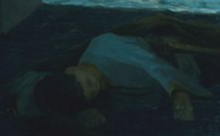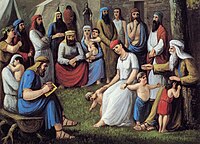Laban (Book of Mormon)
Laban | |
|---|---|
 Laban unconscious (1 Nephi 4:7), as depicted in H. H. Haag's 1894 Nephi and Laban | |
| Personal | |
| Died | Jerusalem |
| Cause of death | Killed by Nephi |
| Era | Reign of Zedekiah |
| Known for | Possessing the brass plates |
Laban (
Narrative
| Part of a series on |
| People in the Book of Mormon |
|---|
 |
Laban appears in First Nephi as a wealthy and politically influential military commander who appears to be[clarification needed] a distant kinsman of Lehi. Laban owns brass plates[clarification needed] and rebuffs both Laman and Nephi in their initial approaches[clarification needed]. Laban attempts to kill them two times, and the second time he steals the Lehi family fortune. Later, Nephi sneaks into Jerusalem and discovers Laban lying drunk in the road. Directed by the Spirit of the Lord, Nephi decapitates Laban. He then puts on Laban's clothing and armor and retrieves the plates.[2]
Interpretations
Brass Plates
This section may lend create a more balanced presentation. Discuss and resolve this issue before removing this message. (March 2024) |
Brant Gardner identified five ways that the plates of Laban were "extremely important",
James Strang, like Joseph Smith, claimed to translate scripture from metal plates. The resulting scripture, the Book of the Law of the Lord, claims to contain at least part of Laban's plates.[5]
Death
Popular Culture
In
See also
- Book of Mormon chronology
- List of plates (Latter Day Saint movement)
References
- IPA-ified from «lā´bun»
- ^ Thomas 2016, pp. 32–33.
- ^ a b Gardner 2007, pp. 100–101.
- ^ Ricks, Stephen D. (1998). "Kingship, Coronation, and Covenant in Mosiah 1--6". In Welch, John W.; Ricks, Stephen D. (eds.). King Benjamin's Speech: "That Ye May Learn Wisdom". Provo, Utah: Foundation for Ancient Research and Mormon Studies. pp. 247–248.
- ^ Beshears, Kyle R. (2021, September 25). "Wingfield Scott Watson and His Struggle to Preserve the Church of Jesus Christ of Latter-Day Saints (Strangite) after the Death of Its Founder" (dissertation). Boyce Digital Repository. Retrieved October 30, 2023, from https://hdl.handle.net/10392/6603.
- ^ a b Swift, Charles (2019). ""The Lord slayeth the wicked": Coming to Terms with Nephi Killing Laban". Journal of Book of Mormon Studies. 86 (1).
- ^ Brigham, Janet (March 29, 2018). "Being Joseph Smith". Dialogue. 33 (2): 187–190.
- ^ Peck, Steven L (2022). "THE SWORD OF LABAN, DELEUZE, AND CLIMATE CHANGE: SLOUCHING TOWARD APOCALYPSE IN THE BOOK OF MORMON". Ships of Hagoth.
- ^ The Book of Mormon Movie, Deseret News.
- ^ The Book of Mormon Movie, Volume 1: The Journey in the Austin Chronicle
Works cited
- Gardner, Brant (2007). Second Witness. Volume 1 First Nephi. Vol. 1. Greg Kofford Books. Wikidata Q123118187.
- Wikidata Q123196681.
Further reading
- Gorton, H. Clay (1994). The Legacy of the Brass Plates of Laban: A Comparison of Biblical & Book of Mormon Isaiah Texts. Cedar Fort. ISBN 0882905112.
- John W. Welch, "Legal Perspectives on the Slaying of Laban" Journal of Book of Mormon Studies 1/1 (1992): 119–41.
- Brett L. Holbrook, "The Sword of Laban as a Symbol of Divine Authority and Kingship," Journal of Book of Mormon Studies 2/1 (1993)
- Val Larsen, "Killing Laban: The Birth of Sovereignty in the Nephite Constitutional Order" Journal of Book of Mormon Studies 16/1 (2007)
- ISBN 0-8849-4699-1.
External links
- LDS research articles on the Sword of Laban
- References to Laban in the index to the LDS edition of The Book of Mormon
- References to brass plates in the index to the LDS edition of The Book of Mormon
- Book of the Law of the Lord, Being a Translation from the Egyptian of the Law Given to Moses in Sinai. The Royal Press, St. James, 1856.
